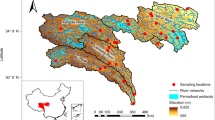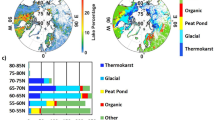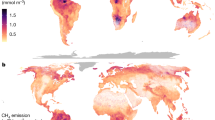Abstract
Large uncertainties in the budget of atmospheric methane, an important greenhouse gas, limit the accuracy of climate change projections1,2. Thaw lakes in North Siberia are known to emit methane3, but the magnitude of these emissions remains uncertain because most methane is released through ebullition (bubbling), which is spatially and temporally variable. Here we report a new method of measuring ebullition and use it to quantify methane emissions from two thaw lakes in North Siberia. We show that ebullition accounts for 95 per cent of methane emissions from these lakes, and that methane flux from thaw lakes in our study region may be five times higher than previously estimated3. Extrapolation of these fluxes indicates that thaw lakes in North Siberia emit 3.8 teragrams of methane per year, which increases present estimates of methane emissions from northern wetlands (< 6–40 teragrams per year; refs 1, 2, 4–6) by between 10 and 63 per cent. We find that thawing permafrost along lake margins accounts for most of the methane released from the lakes, and estimate that an expansion of thaw lakes between 1974 and 2000, which was concurrent with regional warming, increased methane emissions in our study region by 58 per cent. Furthermore, the Pleistocene age (35,260–42,900 years) of methane emitted from hotspots along thawing lake margins indicates that this positive feedback to climate warming has led to the release of old carbon stocks previously stored in permafrost.
This is a preview of subscription content, access via your institution
Access options
Subscribe to this journal
Receive 51 print issues and online access
$199.00 per year
only $3.90 per issue
Buy this article
- Purchase on Springer Link
- Instant access to full article PDF
Prices may be subject to local taxes which are calculated during checkout



Similar content being viewed by others
References
Intergovernmental Panel on Climate Change (IPCC), The Scientific Basis (Cambridge Univ. Press, New York, 2001)
Mikaloff Fletcher, S. E., Tans, P. P., Bruhwiler, L. M., Miller, J. B. & Heimann, M. CH4 source estimated from atmospheric observations of CH4 and its 13C/12C isotopic ratios: 1. Inverse modelling of source processes. Glob. Biogeochem. Cycles 18, GB4004, doi:10.1029/2004GB002223 (2004)
Zimov, S. A. et al. North Siberian lakes: A methane source fuelled by Pleistocene carbon. Science 277, 800–802 (1997)
Roulet, N. T. et al. Role of Hudson Bay lowland as a source of atmospheric methane. J. Geophys. Res. 99, 1439–1454 (1994)
Reeburgh, W. S. et al. A CH4 emission estimate for the Kuparuk River basin, Alaska. J. Geophys. Res. 103, 29005–29013 (1998)
Worthy, D. E., Levin, J. I., Hopper, F., Ernst, M. K. & Trivett, N. B. A. Evidence for a link between climate and northern wetland methane emissions. J. Geophys. Res. 105, 4031–4038 (2000)
Fung, I. et al. Three-dimensional model synthesis of the global methane cycle. J. Geophys. Res. 96, 13033–13065 (1991)
Dlugokencky, E. J., Masarie, K. A., Lang, P. M. & Tans, P. P. Continuing decline in the growth rate of the atmospheric methane burden. Nature 393, 447–450 (1998)
Mostakhov, S. E. in Mezhdunarodnaia conferentsiia po merzlotovedeniiu, Podzemnye vody kriolitosfery (ed. Tolstikhin, N. I.) (Iakustkoe Knizhnoe Izdeatel'stvo, Iakutsk, Russia, 1973)
Romanovskii, N. N. et al. Thermokarst and land-ocean interactions, Laptev Sea Region, Russia. Perm. Periglac. Process. 11, 137–152 (2002)
Zimov, S. A., Schuur, E. A. G. & Chapin, F. S. III Permafrost and the global carbon budget. Science 312, 1612–1613 (2006)
Keller, M. & Stallard, R. F. Methane emission by bubbling from Gatun Lake, Panama. J. Geophys. Res. 99, 8307–8319 (1994)
Casper, P., Maberly, S. C., Hall, G. H. & Finlay, B. J. Fluxes of methane and carbon dioxide from a small productive lake to the atmosphere. Biogeochemistry 49, 1–19 (2000)
Kling, G., Kipphut, G. W. & Miller, M. C. The flux of CO2 and CH4 from lakes and rivers in arctic Alaska. Hydrobiologia 240, 23–36 (1992)
Mathews, E. & Fung, I. Methane emission from natural wetlands: Global distribution, area, and environmental characteristics of sources. Glob. Biogeochem. Cycles 1, 61–86 (1987)
Aselmann, I. & Crutzen, P. J. Global distribution of natural freshwater wetlands, rice paddies, their net primary productivity, seasonality, and possible methane emissions. J. Atmos. Chem. 8, 307–358 (1989)
Phelps, A. R., Peterson, K. M. & Jeffries, M. O. Methane efflux from high-latitude lakes during spring ice melt. J. Geophys. Res. 103, 29029–29036 (1998)
Bartlett, K. B., Crill, P. M., Sass, R. L., Harriss, R. C. & Dise, N. B. Methane emissions from tundra environments in the Yukon-Kuskokwim Delta, Alaska. J. Geophys. Res. 97, 16645–16660 (1992)
Roulet, N. T., Crill, P. M., Comer, N. T., Dove, A. & Boubonniere, R. A. CO2 and CH4 flux between a boreal beaver pond and the atmosphere. J. Geophys. Res. 102, 29313–29319 (1997)
Nakayama, T. Estimation of Methane Emission from Natural Wetlands in Siberian Permafrost Area. 1–100, PhD dissertation, Hokkaido Univ. (1995)
Corradi, C., Kolle, O., Walter, K., Zimov, S. A. & Schulze, E.-D. Carbon dioxide and methane exchange of a north-east Siberian tussock tundra. Glob. Change Biol. 11, 1910–1925 (2005)
Bastviken, D., Cole, J., Pace, M. & Tranvik, L. Methane emissions from lakes: Dependence of lake characteristics, two regional assessments, and a global estimate. Glob. Biogeochem. Cycles 18, GB3010, doi:10.1029/2004GB002238 (2004)
Czudek, T. & Demek, J. Thermokarst in Siberia and its influence on the development of lowland relief. Quat. Res. 1, 103–120 (1970)
Zhuang, Q. et al. Methane fluxes between terrestrial ecosystems and the atmosphere at northern high latitudes during the past century: A retrospective analysis with a process-based biogeochemistry model. Glob. Biogeochem. Cycles 18, GB3010, doi:10.1029/2004GB002239 (2004)
Brown, J., Ferrians, O. J. Jr, Heginbottom, J. A. & Melnikov, E. S. Circum-Arctic Map of Permafrost and Ground-Ice Conditions 1:10,000,000 (US Geological Survey Circum-Pacific Map CP-45, Reston, Virginia, 1997).
Sazonova, T. S., Romanovsky, V. E., Walsh, J. E. & Sergueev, D. O. Permafrost dynamics in the 20th and 21st centuries along the East Siberian transect. J. Geophys. Res. 109, doi:10.1029/2003JD003680 (2004)
Smith, L. C., Sheng, Y., MacDonald, G. M. & Hinzman, L. D. Disappearing arctic lakes. Science 308, 1429 (2005)
Willmott, C. J., & Matsuura, K. Arctic Terrestrial Air Temperature and Precipitation Monthly and Annual Time Series (1930–2000) Version 1 (Univ. Delaware); http://climate.geog.udel.edu/~climate/ or http://rims.unh.edu/data/data.cgi
Nakagawa, F., Yoshida, N., Nojiri, Y. & Makarov, V. N. Production of methane from alasses in eastern Siberia: Implications from its 14C and stable isotope compositions. Global Biogeochem. Cycles 16, doi:10.1029/2000GB001384 (2002)
Stuiver, M. M. & Polach, H. Reporting of 14C data. Radiocarbon 19, 355–363 (1977)
Conrad, R., Klose, M. & Clause, P. Pathway of CH4 formation in anoxic rice field soil and rice roots determined by 13C-stable isotope fractionation. Chemosphere 47, 797–806 (2002)
Romanovsky, N. N. Osnovy Kriogeneza Litosfery (Izdatelstvo Moscow State University, Moscow, 1993)
Acknowledgements
We thank S. P. Davidov and D. A. Draluk for contributions to the research; D. Nidzgorski and E. Carr for field assistance; the Northeast Science Station for logistic support; K. Dutta, T. Schuur and the University of Florida for helping to prepare the radiocarbon targets; S. Marchenko and V. Romanovskii for assistance in analysing Cherskii climate records; and E. Dlugokencky, J. Hobbie, T. Schuur, D. Valentine, and M. S. Bret-Harte for constructive reviews. Research funding was provided by the National Science Foundation through the Russian-American Initiative on Shelf-Land Environments of the Arctic (RAISE) of the Arctic System Science programme (ARCSS) and Polar Programs, the Environmental Protection Agency STAR Fellowship programme, and the NASA Earth System Science Fellowship programme.Author Contributions K.M.W. was the primary investigator in this study, responsible for study design, field work, laboratory measurements, GIS and isotope analyses, data analysis, interpretation and writing. S.A.Z. and F.S.C. contributed to project planning, experimental work, and interpretation of results. J.P.C. assisted with isotope analyses and interpretation. D.V. contributed to the study design and interpretation of the GIS analysis of lake area change. All co-authors provided constructive comments on the manuscript.
Author information
Authors and Affiliations
Corresponding author
Ethics declarations
Competing interests
Reprints and permissions information is available at www.nature.com/reprints. The authors declare no competing financial interests.
Supplementary information
Supplementary Data
This file contains supplementary figures 1–4 and legends, Supplementary Methods, Supplementary equations, Supplementary Tables 1 and 2, and 1 supplementary reference. (PDF 613 kb)
Rights and permissions
About this article
Cite this article
Walter, K., Zimov, S., Chanton, J. et al. Methane bubbling from Siberian thaw lakes as a positive feedback to climate warming. Nature 443, 71–75 (2006). https://doi.org/10.1038/nature05040
Received:
Accepted:
Issue Date:
DOI: https://doi.org/10.1038/nature05040
This article is cited by
-
Characteristics of methane emissions from alpine thermokarst lakes on the Tibetan Plateau
Nature Communications (2023)
-
Panarctic lakes exerted a small positive feedback on early Holocene warming due to deglacial release of methane
Communications Earth & Environment (2023)
-
Metagenomics Unveils Microbial Diversity and Their Biogeochemical Roles in Water and Sediment of Thermokarst Lakes in the Yellow River Source Area
Microbial Ecology (2023)
-
Geochemical, sedimentological and microbial diversity in two thermokarst lakes of far Eastern Siberia
Biogeochemistry (2023)
-
Microporous metal-organic framework materials for efficient capture and separation of greenhouse gases
Science China Chemistry (2023)
Comments
By submitting a comment you agree to abide by our Terms and Community Guidelines. If you find something abusive or that does not comply with our terms or guidelines please flag it as inappropriate.



